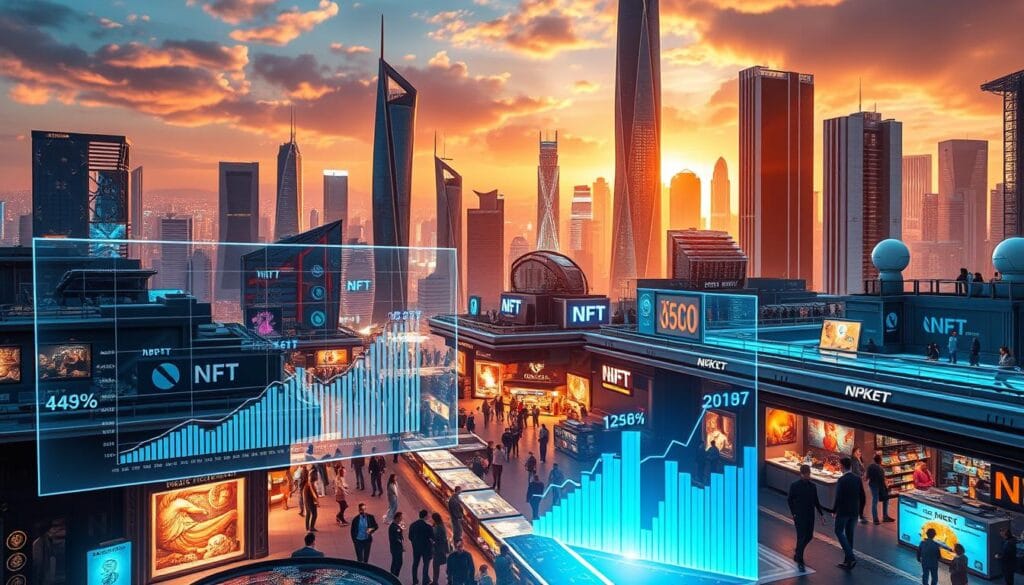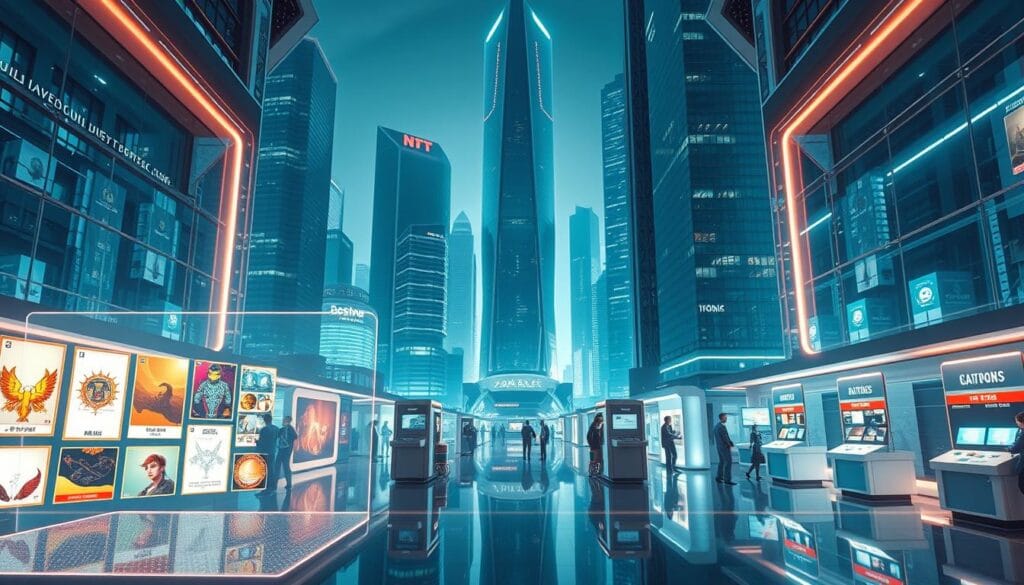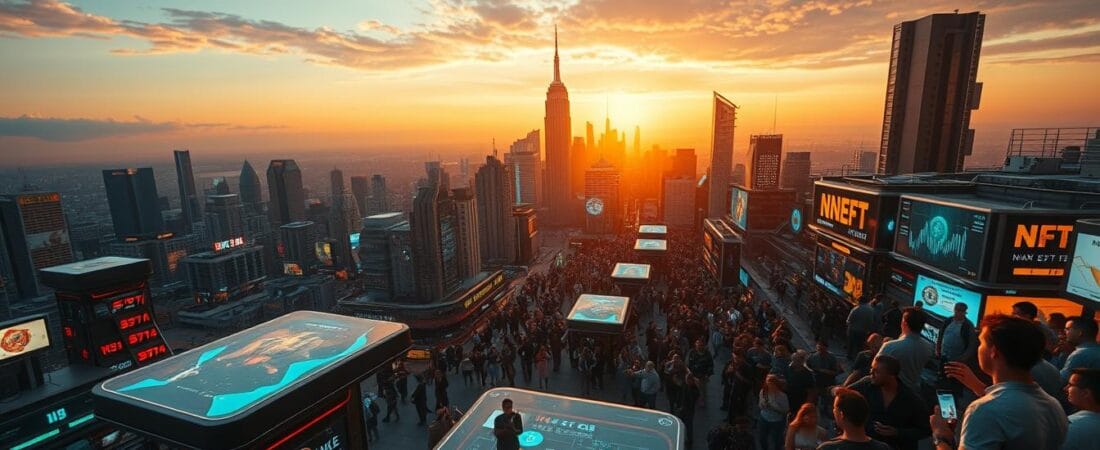The global NFT market is set to grow from $43 billion in 2024 to $61 billion in 2025, marking a 41.6% increase. This growth signals a pivotal shift in how digital assets are perceived and utilized.
Beyond speculative trading, NFTs are now driving innovation in gaming, sports memorabilia, and real-world asset tokenization. This utility-focused approach is attracting a younger audience, with 5% of 18-34 year-olds already owning NFTs.
Institutional interest is also on the rise, with brands like Sorare and NBA Top Shot leading the charge. Additionally, environmental concerns are being addressed through advancements like Ethereum’s proof-of-stake transition.
Emerging trends such as AI integration, regulatory clarity, and cross-platform interoperability are further shaping the future of this dynamic market.
Key Takeaways
- The NFT market is projected to reach $61 billion by 2025.
- Utility-driven applications are becoming the focus.
- Younger demographics are driving adoption.
- Institutional players are increasing their involvement.
- Environmental improvements are being implemented.
- AI and regulatory clarity are emerging trends.
Introduction to NFTs and Their Investment Potential

Non-fungible tokens (NFTs) have transformed the way we perceive ownership and value in the digital age. Unlike traditional cryptocurrencies, these tokens represent unique assets, making them ideal for digital art, collectibles, and more.
What Are NFTs?
NFTs are unique cryptographic tokens that provide verified ownership of digital or physical assets. Built on the Ethereum blockchain, they use standards like ERC-721 and ERC-1155 to ensure uniqueness and indivisibility1. This contrasts with fungible tokens like Bitcoin, which are interchangeable.
The ERC-721 standard, introduced in 2017, has been widely adopted for representing unique items like digital art and collectibles1. ERC-1155, proposed in 2019, offers greater flexibility by supporting both fungible and non-fungible tokens within a single contract1.
Why Invest in NFTs in 2025?
The market for NFTs is maturing rapidly, with projections suggesting a valuation of $247 billion by 20292. This growth is driven by increasing adoption across various sectors, including art, gaming, and real estate.
Environmental concerns are also being addressed. Ethereum’s transition to Proof of Stake (PoS) has reduced energy consumption by 99%, making NFT transactions more sustainable1. Layer-2 solutions further enhance scalability and reduce costs.
Fractional ownership is another key trend. High-value assets like real estate or art can be tokenized, allowing multiple individuals to own a share3. This democratizes access and lowers entry barriers for investors.
Creators are benefiting too. Major marketplaces now enforce a 10.2% royalty standard on secondary sales, ensuring ongoing revenue for artists3. OpenSea CEO Devin Finzer emphasizes a “utility-first” approach, encouraging projects that offer tangible benefits beyond collectibility3.
Top NFT Investment Opportunities for 2025

Blockchain-based assets are reshaping how we perceive ownership and creativity. As the market evolves, certain nft projects stand out for their innovation, community engagement, and long-term value. Below, we explore some of the most promising nft collections that are making waves in the digital world.
CryptoPunks: The Pioneers of NFT Art
CryptoPunks are widely regarded as the pioneers of digital art on the blockchain. Launched in 2017, these 8-bit avatars have become iconic symbols of the nft collections movement. With a floor price of 1.9 ETH ($6,600), they remain a cornerstone of the market.
Bored Ape Yacht Club: A Community-Driven Success
The Bored Ape Yacht Club (BAYC) has built a strong community around its unique ape-themed digital assets. Yuga Labs, the creators, have expanded the ecosystem with real-world events and mutation mechanics, adding layers of utility and engagement.
Mutant Ape Yacht Club: The Next Big Thing
As an extension of BAYC, the Mutant Ape Yacht Club (MAYC) offers a fresh take on the original concept. Its innovative mutation mechanics and growing community make it a standout in the nft projects space.
NodeMonkes: Rising Stars in the NFT Space
NodeMonkes made headlines by selling out in just 30 minutes at 0.04 BTC. Now a top 5 collection, this Bitcoin Ordinals success story has even reached Sotheby’s auctions, showcasing its value and appeal.
Bitcoin Puppets: A Unique Bitcoin-Based Collection
Bitcoin Puppets, with a floor price of 0.15 BTC, is among the top 10 Bitcoin-based nft collections. Its unique aesthetic and cultural significance within the Bitcoin ecosystem set it apart.
Pudgy Penguins: Cute and Collectible
Pudgy Penguins combines environmental activism with a loyalty program, offering tangible utilities for its holders. This blend of cuteness and purpose has driven its success in the market.
Invisible Friends: Mystery and Intrigue
Invisible Friends captivates with its mysterious and artistic designs. Its innovative approach to storytelling through digital assets has garnered a dedicated following.
Mad Lads: Solana’s Finest
Mad Lads, with a floor price of 2.89 ETH, is Solana’s flagship project. Its interactive reward mechanisms and Coral integration make it a standout in the Solana ecosystem.
Stepn: Fitness Meets Blockchain
Stepn introduces a move-to-earn model, combining fitness tracking with nft projects. This innovative approach bridges the gap between physical activity and blockchain technology.
Moonbirds: Fully On-Chain Innovation
Moonbirds stands out with its fully on-chain rendering and Lunar Society membership perks. Its focus on innovation and community engagement makes it a top contender in the space.
For more insights into blockchain platforms, explore our guide on decentralized lending benefits.
Market Trends Shaping NFT Investments in 2025

The digital asset landscape is undergoing significant transformation as utility-driven applications take center stage. The nft market has moved beyond speculative trading, focusing on practical use cases across gaming, real estate, and more. This shift reflects broader trends in the industry, where value is increasingly tied to functionality rather than hype.
From Hype to Utility: The Evolution of NFTs
Gaming has emerged as a dominant force in the nft market, accounting for 58% of sales in 2024. Projects like Axie Infinity and Gods Unchained showcase how digital assets can enhance user experiences. This utility-focused approach is driving adoption among younger demographics and reshaping the industry.
Real estate tokenization is another growing trend. Platforms like Propy and RealT are enabling fractional ownership of properties, making high-value assets more accessible. This innovation highlights the benefits of blockchain technology in democratizing access to traditionally exclusive markets.
Regulatory Changes and Their Impact
The SEC’s Wells notice to OpenSea in 2024 signaled a regulatory shift in the nft market. This move underscores the need for clearer guidelines around digital assets, particularly in classifying them as securities. Such changes are expected to bring more stability and trust to the industry.
Regulatory clarity is also fostering innovation. As governments worldwide develop frameworks, businesses can operate with greater confidence, driving growth and adoption across platforms.
Technological Advancements in Blockchain
Blockchain technology continues to evolve, with platforms like Polygon and Solana offering sub-$0.01 minting fees. These advancements are enabling mass adoption by reducing costs and improving scalability. Additionally, the development of interoperability standards through initiatives like the Cross-Chain NFT Working Group is enhancing the functionality of digital assets.
AI-generated art is another area of growth, projected to capture 23% of the nft market by Q4 2025. This trend highlights the intersection of creativity and technology, offering new opportunities for artists and collectors alike.
For more insights into blockchain platforms, explore our guide on effective cryptocurrency trading strategies.
Expert Opinions on NFT Investments in 2025

Industry leaders are shaping the future of digital assets with innovative strategies and insights. Their perspectives highlight the evolving potential of this space, focusing on utility, community, and long-term growth.
Devin Finzer on the Future of NFTs
Devin Finzer, CEO of OpenSea, emphasizes a shift toward utility-driven projects. “The era of pure collectibles is over,” he states. This approach encourages creators to focus on tangible benefits, ensuring sustained value for investors.
OpenSea’s recent initiatives align with this vision, prioritizing projects that offer real-world applications. This strategy aims to attract a broader audience while maintaining trust in the market.
Frank DeGods on Community-Centric NFTs
Frank DeGods, a prominent figure in the digital asset space, champions community-driven models. His dual-token system, featuring $DE and $DUST, enhances liquidity and engagement.
This innovative approach fosters deeper connections between creators and investors. By integrating fungible tokens, DeGods ensures greater access and flexibility within the ecosystem.
Yat Siu’s Optimistic Outlook
Yat Siu, co-founder of Animoca Brands, predicts a resurgence in demand driven by AI integration. He highlights regulatory advancements in Asia as a key driver of growth.
“The convergence of AI and digital assets will unlock new opportunities,” Siu explains. His optimism is backed by Animoca’s expanding portfolio, which includes projects like Sorare, valued at $680 million.
For more insights into the evolving landscape, explore our guide on the best marketplaces of 2025.
Emerging Use Cases for NFT Collectibles

The integration of blockchain technology into various industries has opened new doors for digital collectibles. These unique assets are now being utilized in innovative ways, transforming how we interact with gaming, sports, music, and even real-world properties.
Gaming Assets and Virtual Worlds
In the gaming industry, digital collectibles are revolutionizing player experiences. Projects like Axie Infinity have attracted 2.8 million daily active users, showcasing the potential of play-to-earn models. Virtual land in platforms like Decentraland is also gaining traction, with parcels trading at an average of $15,000.
Sports Memorabilia and Fan Engagement
Sports fans are embracing digital collectibles as a way to connect with their favorite teams. NBA Top Shot has set a benchmark with over $1 billion in lifetime sales, proving the demand for tokenized sports moments. Fan tokens, like those from Mercedes-AMG Petronas, are also enhancing engagement through governance features.
Music and Entertainment Collectibles
The music industry is leveraging digital collectibles to create new revenue streams. Platforms like Royal.io enable artists to share royalties, with 14.7% of streaming revenue going directly to token holders. This approach empowers creators while offering fans unique access to their favorite artists.
Real-World Assets and New Domains
Digital collectibles are bridging the gap between the virtual and physical worlds. Luxury brands like Gucci and RTFKT are merging digital and physical assets, creating exclusive collectibles for their audiences. Fractionalized art ownership is also gaining popularity, allowing multiple individuals to co-own high-value pieces like Basquiat’s works.
How to Choose the Right NFT Projects

Selecting the right digital asset requires careful evaluation of key factors. Rarity, community engagement, and long-term utility are critical elements that determine the value and success of a project. Conducting thorough research can help investors make informed decisions.
Rarity and Scarcity
Rarity is a defining characteristic of high-value digital assets. Projects like CryptoPunks showcase this with Alien Punks, which have a rarity score of just 0.15%. Evaluating trait rarity and total supply can provide insights into a project’s uniqueness. Overminted projects often lose appeal, while sustainable release models maintain value over time.
Popularity and Community Support
A strong community is a hallmark of successful projects. For example, Bored Ape Yacht Club’s Discord boasts 650,000 members with an 89% engagement rate. Active governance participation and frequent interactions indicate a healthy ecosystem. Investors should look for projects with vibrant, engaged communities.
Utility and Long-Term Value
Utility-driven projects offer tangible benefits beyond collectibility. Features like staking rewards, real-world events, and cross-project airdrops enhance long-term value. Moonbirds’ nesting mechanism, for instance, has driven high holder retention by offering exclusive perks. Assessing a project’s utility checklist can reveal its potential for sustained success.
For more insights into high-potential projects, explore our guide on the best digital collectibles.
Navigating NFT Marketplaces in 2025

Digital asset platforms are evolving rapidly, offering diverse opportunities for creators and collectors alike. These nft marketplaces provide unique spaces for trading, showcasing, and discovering digital content. As the industry matures, understanding the features and benefits of each platform becomes essential for making informed decisions.
OpenSea: The Largest NFT Marketplace
OpenSea remains a dominant player in the nft marketplaces space, generating $684 million in revenue in 2024 despite an 11% year-over-year decline. Its user-friendly interface and support for a wide range of digital assets make it a go-to platform for both beginners and experienced collectors. OpenSea charges a 2.5% fee on sales, which is competitive compared to other platforms.
Security is a priority for OpenSea, with features like Ledger integration and phishing detection systems. These measures ensure a safe environment for users to trade and explore digital content.
Nifty Gateway: A Platform for Exclusive Drops
Nifty Gateway stands out for its exclusive drops and partnerships with high-profile artists like Beeple. This platform requires an invitation or application, making it a more selective space for creators and collectors. Its focus on premium content has attracted a dedicated audience, driving significant sales for featured artists.
Nifty Gateway’s curation process ensures that only high-quality digital assets are showcased. This exclusivity adds value to the platform and enhances the overall user experience.
Rarible: A Decentralized Marketplace
Rarible offers a decentralized approach to trading digital assets, with a unique governance model powered by its RARI token. Holders of RARI enjoy benefits like 0% creator fees, making it an attractive option for artists. The platform’s community-driven ethos fosters innovation and collaboration among users.
Rarible’s lazy minting feature allows creators to list their work without upfront costs, reducing barriers to entry. This flexibility, combined with its focus on community ownership, positions Rarible as a forward-thinking player in the nft marketplaces space.
For more insights into blockchain platforms, explore our guide on blockchain crowdfunding.
Risks and Challenges in NFT Investments
The digital asset space, while promising, is not without its share of challenges. From market volatility to regulatory hurdles, investors must navigate several risks to make informed decisions. Understanding these factors is crucial for long-term success.
Market Volatility
The market for digital assets is highly unpredictable. For instance, the floor price of Bored Ape Yacht Club (BAYC) experienced a 74% drawdown from its all-time high. Such fluctuations can lead to significant losses for investors who fail to time their entries and exits correctly.
Wash trading is another concern, with 34% of reported volume suspected to be artificially inflated. This practice distorts market data, making it harder for investors to assess true value.
Regulatory Uncertainty
Regulatory clarity remains a major challenge. The ongoing Ripple case with the SEC has set a precedent that could impact how digital assets are classified. This uncertainty creates hesitation among investors and slows growth in the sector.
Legal disputes, such as the Hermès vs MetaBirkins trademark ruling, further complicate the landscape. These cases highlight the need for clear guidelines to protect both creators and investors.
Environmental Concerns
While technology advancements have reduced energy consumption, environmental concerns persist. Ethereum’s transition to Proof of Stake (PoS) has lowered its energy use to 0.01 TWh post-Merge. However, other chains like Solana and Tezos still face scrutiny over their carbon footprints.
Addressing these issues requires ongoing research and innovation. Sustainable practices will be key to ensuring the long-term viability of digital assets.
Strategies for Successful NFT Investing
Navigating the digital asset space requires a strategic approach to maximize returns and minimize risks. Whether you’re a seasoned investor or just starting, understanding key strategies can significantly enhance your potential for success.
Diversification
Diversifying your portfolio is essential in managing risk. Allocating 60% to established projects and 40% to emerging ones can balance stability with growth opportunities. This approach ensures you’re not overly reliant on a single asset, reducing vulnerability to market fluctuations.
Tools like Nansen wallet tracking and NFTBank valuations can help you assess the value of different assets. By spreading your investments across various sectors, you can better weather market volatility.
Research and Due Diligence
Thorough research is the cornerstone of successful investing. Platforms like DappRadar offer a 92% accuracy rate in project vetting, helping you make informed decisions. Analyzing on-chain data and historical sales trends can provide valuable insights into a project’s viability.
Engaging with communities on platforms like Twitter Spaces or DAO forums can also offer sentiment analysis. This helps gauge public perception and identify emerging opportunities before they gain widespread attention.
Long-Term vs. Short-Term Investments
Deciding between long-term and short-term strategies depends on your financial goals. 73% of profitable investors hold their assets for over 18 months, highlighting the benefits of a long-term approach. This allows for compounding returns and reduces the impact of short-term market swings.
For those preferring short-term gains, optimizing gas fees during low-congestion periods and utilizing stop-loss triggers can enhance profitability. Yield farming mechanisms, such as BAYC/MAYC dual staking, also offer passive income opportunities.
For more detailed insights, explore our guide on NFT trading strategies.
Conclusion: The Future of NFT Investments in 2025
The evolving landscape of digital assets continues to redefine value and ownership in the modern world. As the market matures, utility-driven applications are taking center stage, supported by advancements in blockchain technology and AI integration. Animoca Brands’ projection of a $247 billion valuation by 2029 underscores the sector’s growth potential.
However, investors should exercise caution. Overexposure to speculative meme projects can lead to significant risks. A balanced portfolio with exposure to real-world assets, such as automotive nfts and academic credentials, offers a more sustainable approach.
Regulatory clarity is also shaping the space, fostering trust and innovation. As the world of digital assets evolves, doing your own research (DYOR) remains crucial. For deeper insights, explore the pros and cons of investing in this dynamic.
Stay ahead of the curve by subscribing for updates on the Q3 2025 market analysis. The future of digital assets is bright, but informed decisions are key to success.

